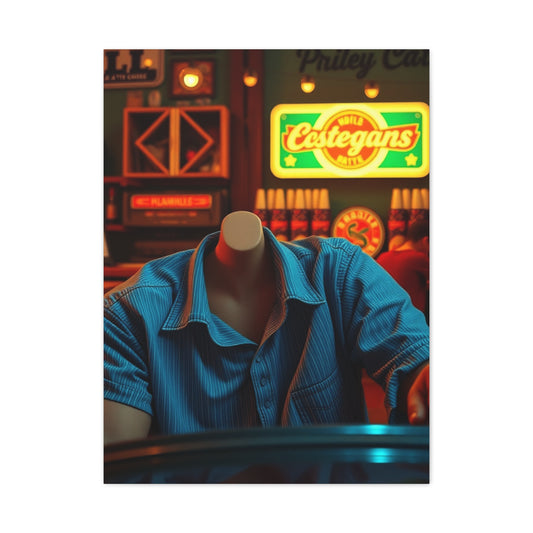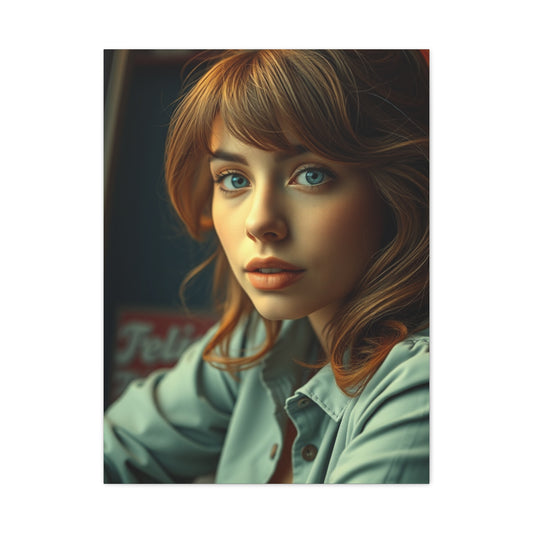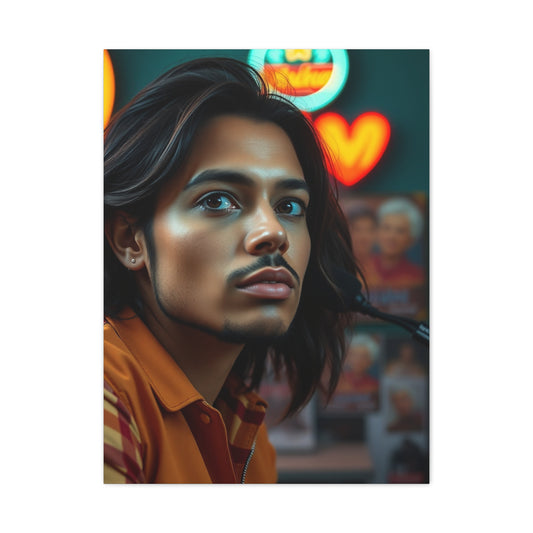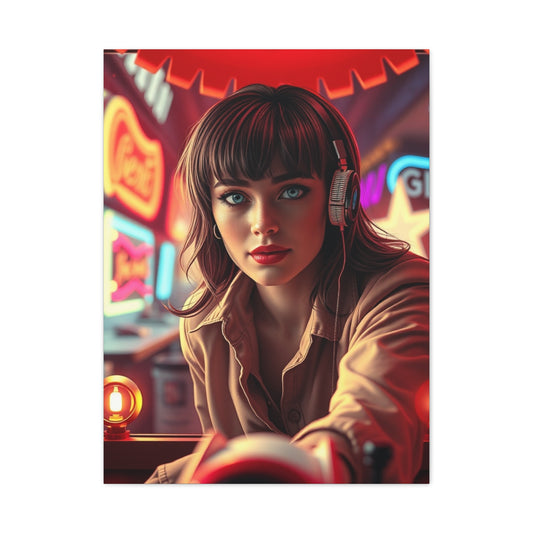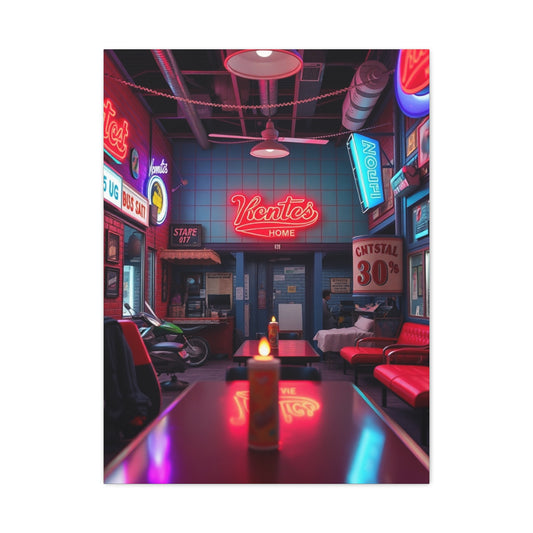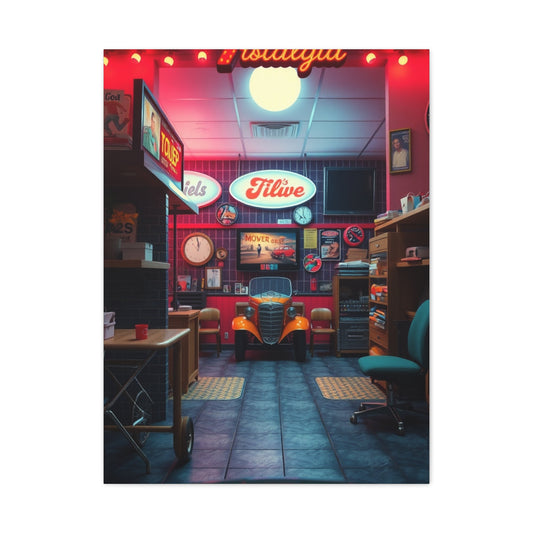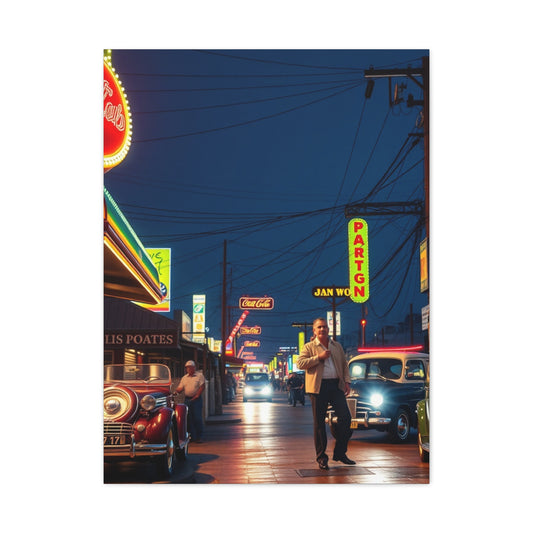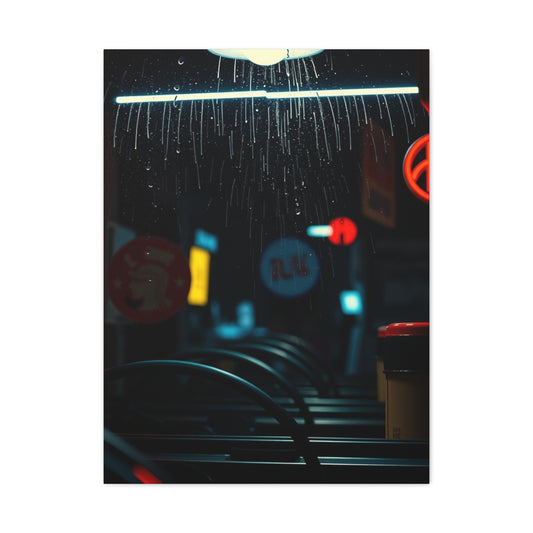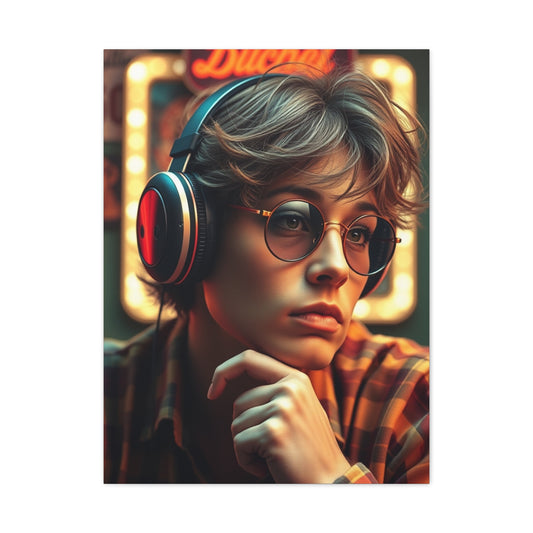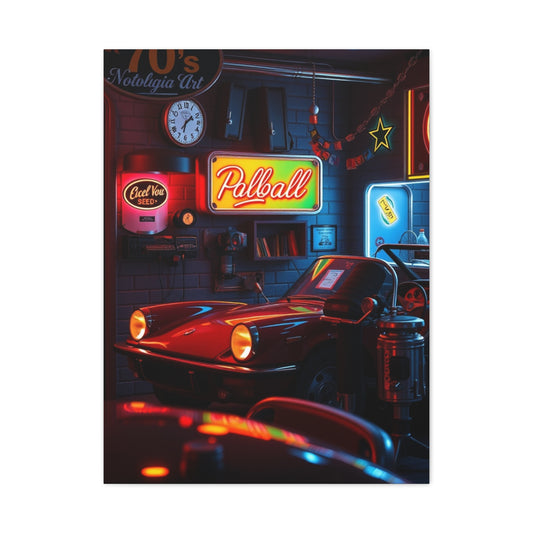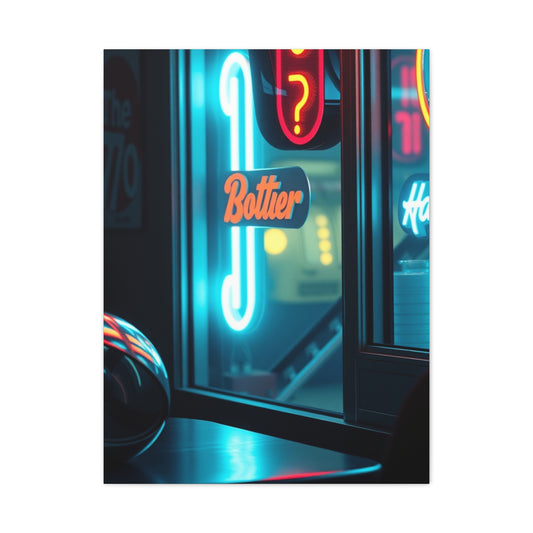Nostalgic Renaissance: Transformative 70’s Nostalgia Wall Art for the Home
The extraordinary resurgence of 1970s home decor represents one of contemporary interior design's most captivating phenomena, as homeowners increasingly embrace the era's distinctive aesthetic principles that emphasized authenticity, environmental consciousness, and radical departure from conventional decorative paradigms. This nostalgic renaissance reflects deeper cultural yearnings for genuine expression, sustainable materials, and spaces that prioritize human comfort over institutional sterility.
The transformative power of 1970s home decor extends far beyond superficial stylistic choices to encompass fundamental philosophical approaches to living space creation that emphasized harmony between occupants and their environments. This remarkable era introduced revolutionary concepts about color psychology, material authenticity, and spatial relationships that continue influencing contemporary design professionals while inspiring homeowners seeking alternatives to mass-produced aesthetic solutions.
Understanding the enduring appeal of 1970s home decor requires examining the complex cultural, technological, and artistic forces that shaped this extraordinary period of domestic innovation. The decade's design philosophy emerged from countercultural movements, environmental awareness, and rejection of rigid modernist principles that had dominated previous generations while establishing new standards for residential comfort, creativity, and personal expression.
The contemporary revival of 1970s home decor demonstrates remarkable adaptability as modern practitioners successfully integrate period-specific elements with current lifestyle requirements, technological infrastructure, and sustainability concerns. This successful fusion creates living spaces that honor historical precedent while meeting contemporary functional demands and aesthetic preferences that reflect evolved understanding of domestic comfort and environmental responsibility.
Revolutionary Color Philosophy and Chromatic Expression
The extraordinary color palette that defined 1970s home decor represented a radical departure from previous decades' restrained approaches while establishing bold new standards for residential chromatic expression that celebrated earthiness, warmth, and psychological comfort over conventional decorative propriety. This revolutionary approach to interior color application drew inspiration from natural phenomena, cultural movements, and emerging understanding of color psychology's impact on human wellbeing and social interaction.
Avocado green emerged as the decade's most iconic color choice, representing connection to natural environments while symbolizing growth, renewal, and environmental consciousness that resonated with period social movements. This distinctive hue appeared across multiple applications including major appliances, wall treatments, textile selections, and decorative accessories that created cohesive chromatic environments celebrating organic inspiration and ecological awareness.
Harvest gold established itself as another fundamental color within the 1970s palette, evoking warmth, abundance, and connection to agricultural traditions while providing sophisticated alternative to traditional yellow applications. This rich, complex tone worked harmoniously with other period colors while creating inviting atmospheres that encouraged relaxation, contemplation, and social gathering within domestic environments designed for genuine human interaction.
Burnt orange achieved extraordinary prominence during this period, representing dynamic energy, creativity, and confident self-expression that reflected broader cultural movements toward authenticity and personal liberation. This vibrant yet sophisticated color choice demonstrated homeowners' willingness to embrace bold chromatic statements while creating visually stimulating environments that celebrated individuality over conformity.
Chocolate brown functioned as essential grounding element within 1970s color schemes, providing stability and sophistication that balanced more adventurous color choices while referencing natural materials and environmental connections. This rich, complex neutral enabled successful integration of diverse chromatic elements while creating foundational base that supported experimental color combinations and pattern applications.
The psychological impact of 1970s color choices extended beyond aesthetic considerations to influence mood, behavior, and social interaction within domestic environments designed to support authentic human experience. Research from this period demonstrated significant connections between color selection and emotional wellbeing, leading to more thoughtful approaches to residential chromatic design that prioritized occupant comfort and psychological health.
Texture integration became crucial component of 1970s color application, as designers recognized that chromatic impact depended heavily on surface treatments, material choices, and tactile qualities that enhanced visual experience through multisensory engagement. This sophisticated understanding led to innovative combinations of smooth and rough surfaces, matte and glossy finishes, and natural and synthetic materials that created complex visual experiences transcending simple color relationships.
Innovative Architectural Elements and Structural Expression
The revolutionary architectural approaches that emerged during the 1970s fundamentally transformed residential design philosophy while introducing innovative structural elements that prioritized flexibility, openness, and integration between indoor and outdoor environments. These extraordinary developments challenged traditional compartmentalization of domestic space while creating more fluid, adaptable living environments that responded to changing lifestyle patterns and family structures.
Sunken living rooms represented one of the most distinctive architectural innovations of the 1970s, creating intimate gathering spaces that fostered social interaction while establishing visual hierarchy within open floor plans. These depressed seating areas required sophisticated engineering solutions while creating dramatic spatial experiences that distinguished formal entertaining spaces from everyday circulation areas through thoughtful level changes and integrated seating solutions.
Conversation pits achieved remarkable popularity during this period, providing circular or semi-circular seating arrangements that encouraged face-to-face interaction while creating cozy environments within larger architectural contexts. These innovative spatial solutions challenged traditional furniture arrangements while demonstrating renewed interest in communal activities and social engagement that reflected period cultural values and lifestyle preferences.
Exposed beam construction gained widespread acceptance as homeowners embraced structural honesty while celebrating natural materials and construction processes previously concealed within finished interior surfaces. This architectural approach created visual interest through structural expression while connecting interior spaces to broader environmental contexts through material authenticity and craftsmanship celebration.
Open floor plans achieved new sophistication during the 1970s as architects developed innovative approaches to spatial definition that maintained visual continuity while providing functional separation between different activity zones. These revolutionary planning concepts required careful attention to sight lines, traffic patterns, and acoustic considerations while creating flexible environments that could adapt to diverse family needs and entertainment requirements.
Cathedral ceilings and dramatic vertical spaces became signature elements of 1970s residential architecture, creating expansive interior volumes that enhanced natural light penetration while establishing connection to outdoor environments. These soaring spaces required innovative heating and cooling solutions while creating opportunities for dramatic lighting installations and large-scale artistic displays that reflected period emphasis on environmental integration and spatial grandeur.
The integration of natural materials within architectural elements achieved extraordinary sophistication during this period, as designers successfully combined wood, stone, brick, and other organic materials to create harmonious interior environments that celebrated material authenticity while providing visual warmth and tactile richness. These material combinations required careful detailing and craftsmanship while creating lasting architectural features that continued influencing contemporary design practice.
Distinctive Furniture Design Philosophy and Material Innovation
The extraordinary furniture design evolution that characterized the 1970s established entirely new paradigms for residential furnishing that prioritized comfort, informality, and material authenticity over traditional formality and decorative elaboration. This revolutionary approach to furniture creation reflected broader cultural shifts toward casualness, environmental consciousness, and rejection of hierarchical social structures that had influenced previous generations' decorative choices and lifestyle expressions.
Low-profile seating arrangements became defining characteristic of 1970s interior design, creating relaxed atmospheres that encouraged casual interaction while establishing visual connection between occupants and floor-level activities. These innovative furniture configurations included floor cushions, modular seating systems, and dramatically scaled-down traditional forms that created intimate environments suitable for contemporary lifestyle patterns and social expectations.
Modular furniture systems achieved remarkable sophistication during this period, enabling homeowners to create customized arrangements that could adapt to changing needs while maintaining design coherence and aesthetic unity. These revolutionary furniture concepts reflected growing interest in flexibility, personalization, and efficient space utilization while providing affordable alternatives to traditional matched furniture sets that had dominated previous decorative approaches.
Bean bag chairs represented radical departure from conventional seating concepts while providing ultimate flexibility and comfort that appealed to younger generations seeking alternatives to formal furniture traditions. These innovative seating solutions utilized synthetic materials and unconventional forms while creating casual environments that supported relaxed lifestyle patterns and informal entertainment approaches.
Platform beds eliminated traditional bed frames while creating sleek, minimalist sleeping environments that emphasized horizontal lines and integrated storage solutions. These revolutionary furniture pieces reflected changing attitudes toward bedroom design while providing practical alternatives to conventional bed construction that supported period aesthetic preferences for simplicity and functionality.
Rattan and wicker furniture experienced extraordinary revival during the 1970s as homeowners embraced natural materials and craftsmanship traditions that connected interior environments to broader ecological contexts. These sustainable furniture choices provided visual texture and environmental authenticity while supporting growing interest in handcrafted objects and traditional production methods that contrasted with mass-produced synthetic alternatives.
Brass and chrome accents achieved widespread popularity throughout 1970s furniture design, providing metallic highlights that enhanced period color palettes while adding sophisticated finishing touches to both traditional and contemporary furniture forms. These metallic elements required careful integration within overall design schemes while creating opportunities for dramatic lighting effects and visual emphasis that supported period aesthetic preferences.
The psychological impact of 1970s furniture design extended beyond immediate comfort considerations to influence social behavior, family interaction patterns, and domestic lifestyle choices that reflected broader cultural values about informality, authenticity, and environmental consciousness. This furniture philosophy encouraged more relaxed approaches to domestic life while supporting genuine human interaction and personal expression within residential environments.
Revolutionary Lighting Concepts and Atmospheric Creation
The extraordinary lighting innovations that emerged during the 1970s fundamentally transformed approaches to residential illumination while establishing new standards for atmospheric creation that prioritized mood enhancement, energy efficiency, and decorative integration over purely functional considerations. This revolutionary period witnessed remarkable creativity in lighting design that reflected broader cultural interests in consciousness exploration, environmental awareness, and rejection of institutional lighting approaches.
Lava lamps achieved iconic status as quintessential 1970s lighting elements, combining functional illumination with mesmerizing visual entertainment that reflected period fascination with altered consciousness and psychedelic aesthetics. These extraordinary devices utilized heated wax suspension to create continuously changing visual displays while providing ambient lighting that contributed to relaxed, contemplative atmospheres suitable for period lifestyle preferences and entertainment approaches.
Macrame pendant lighting emerged as distinctive craft-based illumination solution that combined handmade aesthetics with functional lighting requirements while celebrating traditional fiber arts and sustainable material utilization. These unique lighting fixtures required considerable skill and time investment while creating personalized decorative elements that reflected individual creativity and connection to artisanal production methods.
Track lighting systems gained widespread residential acceptance during the 1970s, providing flexible illumination solutions that could adapt to changing furniture arrangements while supporting period preferences for modular, adjustable interior elements. These innovative lighting approaches enabled homeowners to create customized illumination schemes while maintaining design flexibility and accommodation for evolving spatial requirements and activity patterns.
Colored lighting effects achieved remarkable popularity through various technological innovations including colored bulbs, filtered fixtures, and experimental lighting systems that created dramatic atmospheric effects supporting period entertainment and social activities. These innovative lighting applications reflected growing interest in sensory enhancement and environmental manipulation while providing alternatives to conventional white light illumination.
Dimmer controls became essential components of sophisticated 1970s lighting schemes, enabling precise atmospheric control that could adapt to different activities, times of day, and social situations while supporting period emphasis on mood creation and environmental customization. These technological innovations required electrical system upgrades while providing enhanced control over residential lighting environments and energy consumption.
Candle lighting experienced significant revival during the 1970s as homeowners embraced natural illumination sources that provided warmth, romance, and connection to traditional lighting methods while supporting growing interest in environmental sustainability and authentic experience. This renewed appreciation for candlelight led to sophisticated candle holder designs and innovative wax formulations that enhanced safety while maintaining atmospheric appeal.
The integration of natural light became crucial consideration within 1970s interior design, as architects and decorators developed innovative approaches to window treatments, skylights, and light wells that maximized daylight penetration while controlling glare and heat gain. These daylighting strategies supported period environmental consciousness while creating healthier interior environments that maintained connection to outdoor conditions and seasonal changes.
Textile Innovation and Pattern Revolution
The extraordinary textile developments that characterized 1970s home decor represented fundamental shifts in pattern design, material selection, and application techniques that challenged traditional decorative approaches while establishing new standards for residential textile utilization. This revolutionary period witnessed remarkable creativity in fabric design that reflected broader cultural movements toward authenticity, environmental consciousness, and personal expression through domestic environments.
Shag carpeting achieved unprecedented popularity during the 1970s, providing luxurious tactile experiences while creating visually dramatic floor treatments that became signature elements of period interior design. These deep-pile carpet installations required specialized maintenance techniques while providing superior comfort and acoustic properties that enhanced residential environments and supported period preferences for casual, comfortable living arrangements.
Macrame wall hangings emerged as distinctive decorative elements that combined textile arts with sculptural expression while celebrating handcraft traditions and sustainable material utilization. These intricate fiber artworks required considerable skill and time investment while creating personalized decorative statements that reflected individual creativity and connection to artisanal production methods that contrasted with mass-produced decorative alternatives.
Bold geometric patterns achieved extraordinary prominence throughout 1970s textile design, incorporating mathematical precision with vibrant color combinations that created visually stimulating environments supporting period aesthetic preferences for dynamic, energetic interior spaces. These innovative pattern approaches required sophisticated printing technologies while providing opportunities for dramatic decorative statements that reflected period cultural values and artistic movements.
Natural fiber emphasis became fundamental principle of 1970s textile selection, as consumers increasingly prioritized cotton, wool, hemp, and other organic materials over synthetic alternatives while supporting growing environmental consciousness and preference for authentic material experiences. This natural fiber preference influenced manufacturing practices while creating more sustainable textile markets that supported traditional production methods and agricultural communities.
Velvet upholstery experienced remarkable revival during the 1970s, providing luxurious tactile experiences while creating sophisticated visual effects that enhanced both traditional and contemporary furniture forms. These rich fabric applications required specialized cleaning and maintenance while providing superior comfort and acoustic properties that contributed to period preferences for sensual, comfortable interior environments.
Batik and tie-dye techniques gained widespread acceptance within mainstream home decorating during this period, bringing counterculture aesthetic influences into conventional residential environments while celebrating handcraft traditions and individual creative expression. These unique textile treatments provided one-of-a-kind decorative elements while supporting period values about authenticity and personal involvement in domestic environment creation.
The layering of diverse textile elements became sophisticated design strategy during the 1970s, as decorators developed innovative approaches to combining different patterns, textures, and colors within unified decorative schemes. This complex layering required careful attention to scale relationships, color harmonies, and visual balance while creating rich, multisensory environments that supported period preferences for complex, stimulating interior experiences.
Innovative Accessory Integration and Decorative Philosophy
The extraordinary accessory selections that defined 1970s home decor represented fundamental shifts in decorative philosophy that prioritized personal expression, cultural diversity, and environmental consciousness over traditional ornamental approaches. This revolutionary period witnessed remarkable creativity in accessory selection and arrangement that reflected broader cultural movements toward authenticity, global awareness, and rejection of conventional decorative hierarchies.
Indoor plant cultivation achieved unprecedented popularity during the 1970s, transforming residential environments through extensive botanical integration that provided natural air purification while creating living decorative elements that changed seasonally and required ongoing care and attention. This plant enthusiasm reflected growing environmental consciousness while supporting period preferences for natural elements and sustainable lifestyle practices within domestic environments.
Ceramic pottery experienced remarkable artistic development during this period, as both professional artists and amateur crafters embraced clay working as creative expression while producing functional and decorative objects that celebrated handcraft traditions and material authenticity. These ceramic explorations produced unique decorative elements while supporting period values about individual creativity and connection to traditional production methods.
Vintage and antique collecting gained sophisticated appreciation during the 1970s, as homeowners increasingly valued objects with historical significance and individual character over mass-produced decorative items while supporting growing interest in cultural preservation and sustainable consumption practices. This collecting enthusiasm created eclectic decorative environments while fostering appreciation for craftsmanship traditions and historical continuity.
Wall art selections became more diverse and personal during this period, incorporating poster art, photography, textile hangings, and sculptural elements that reflected individual interests and cultural connections while challenging traditional fine art hierarchies. These varied wall treatments created personalized environments while supporting period values about democratic access to artistic expression and cultural diversity.
Global decorative influences achieved remarkable prominence during the 1970s, as increased international travel and cultural exchange introduced diverse aesthetic traditions that enriched American decorative vocabularies while challenging Eurocentric design assumptions. These international influences included Asian textile traditions, African sculptural forms, and Latin American craft techniques that created more culturally diverse and globally conscious interior environments.
Religious and spiritual iconography gained acceptance within secular decorative contexts during this period, reflecting growing interest in alternative spirituality and consciousness exploration while challenging traditional boundaries between sacred and domestic spaces. These spiritual elements provided meaningful decorative content while supporting period preferences for authentic personal expression and philosophical exploration within residential environments.
The curation of personal collections became sophisticated decorative strategy during the 1970s, as homeowners developed innovative approaches to displaying books, records, crafts, and other personal objects that reflected individual interests while creating meaningful interior environments that told personal stories and supported ongoing activities and hobbies.
Contemporary Application and Modern Integration
The successful integration of 1970s home decor elements within contemporary residential environments requires sophisticated understanding of both historical context and current lifestyle requirements while maintaining authentic aesthetic character that honors period design principles without creating museum-like environments unsuitable for modern living patterns. This challenging balance demands careful selection, thoughtful adaptation, and creative interpretation that preserves essential characteristics while accommodating contemporary functional needs.
Statement furniture pieces provide excellent opportunities for incorporating 1970s aesthetic elements without committing to comprehensive period decoration while creating focal points that establish design themes and provide conversation starters within otherwise contemporary interior environments. These carefully selected pieces might include iconic seating, distinctive lighting fixtures, or unique storage solutions that capture period character while providing practical utility for current occupants.
Color palette adaptation enables homeowners to embrace 1970s chromatic principles while adjusting intensity, saturation, and application techniques to accommodate contemporary aesthetic preferences and lifestyle requirements. This sophisticated color work might involve using period-inspired hues in different proportions, combining traditional colors with contemporary neutrals, or applying vintage colors through modern materials and techniques that provide familiar comfort with updated practicality.
Textile integration offers versatile approaches to incorporating 1970s aesthetic elements through cushions, throws, window treatments, and small-scale applications that can be easily changed or updated while providing authentic period character without overwhelming contemporary furniture or architectural elements. These textile applications enable experimental approaches to period decoration while maintaining flexibility for future changes or adjustments.
Lighting solutions can successfully incorporate 1970s atmospheric principles through carefully selected fixtures, innovative controls, and creative applications that provide period character while accommodating contemporary safety standards and energy efficiency requirements. Modern LED technology enables authentic reproduction of period lighting effects while providing superior performance and reduced environmental impact that supports contemporary sustainability values.
Accessory selection provides low-commitment opportunities for exploring 1970s decorative elements through carefully chosen objects that can enhance contemporary environments without requiring major changes to existing decoration or significant financial investment. These accessory experiments enable gradual introduction of period elements while allowing homeowners to evaluate their comfort with vintage aesthetic principles and their compatibility with current lifestyle patterns.
The successful balance between authentic period character and contemporary functionality requires ongoing attention to proportion, scale, and integration that respects both historical precedent and current needs while creating harmonious environments that feel authentic rather than contrived or theatrical. This sophisticated design work demands patience, experimentation, and willingness to adjust approaches based on lived experience within evolving interior environments.
Sustainable Principles and Environmental Consciousness
The environmental consciousness that characterized 1970s home decor philosophy provided prescient foundation for contemporary sustainability practices while establishing principles about material selection, energy efficiency, and ecological responsibility that remain relevant for current environmental challenges and consumer awareness. This remarkable foresight enables contemporary practitioners to honor period aesthetic principles while addressing urgent environmental concerns through thoughtful design choices and responsible consumption practices.
Natural material emphasis within 1970s decoration established important precedents for sustainable design practice while demonstrating successful integration of organic materials that provided superior performance characteristics compared to synthetic alternatives while supporting traditional craft industries and agricultural communities. These material choices continue providing viable options for contemporary homeowners seeking environmentally responsible alternatives to petroleum-based decorative products.
Handcraft appreciation during the 1970s supported artisanal production methods that reduced environmental impact while providing superior quality and individual character compared to mass-produced alternatives. This craft emphasis established consumer appreciation for skilled workmanship while creating economic support for traditional production methods that maintain cultural knowledge and provide alternatives to industrial manufacturing systems.
Vintage and antique utilization reflected period commitment to resource conservation while providing access to superior construction quality and distinctive aesthetic character that contrasted favorably with contemporary mass production standards. This reuse philosophy anticipated current circular economy principles while demonstrating practical approaches to waste reduction and cultural preservation that remain relevant for contemporary sustainability practice.
Energy-efficient lighting approaches developed during the 1970s established important precedents for contemporary energy conservation while providing atmospheric control and mood enhancement that improved residential comfort without excessive resource consumption. These lighting strategies continue providing valuable guidance for contemporary homeowners seeking to reduce energy usage while maintaining attractive and functional interior illumination.
The longevity emphasis within 1970s design philosophy encouraged investment in durable materials and construction methods that provided extended service life while reducing replacement frequency and associated environmental impact. This quality-focused approach contrasted with planned obsolescence strategies while establishing consumer appreciation for lasting value that transcends temporary fashion trends.
Indoor air quality considerations within 1970s design practice recognized connections between material selection and occupant health while promoting natural materials and adequate ventilation that supported healthy interior environments. These health-conscious approaches provided foundation for contemporary understanding of toxic material impacts while establishing preferences for non-toxic alternatives that continue influencing responsible design practice.
Professional Implementation and Design Services
The successful implementation of 1970s home decor within contemporary residential environments often requires professional design expertise that combines historical knowledge with contemporary technical requirements while navigating complex challenges related to building codes, energy efficiency, and lifestyle accommodation. Professional design services provide valuable guidance for homeowners seeking authentic period character without compromising contemporary comfort or functionality requirements.
Historical research capabilities enable design professionals to identify authentic period elements while distinguishing genuine vintage materials from contemporary reproductions that may lack appropriate character or quality standards. This expertise prevents costly mistakes while ensuring successful aesthetic integration that honors period design principles through appropriate material selection and application techniques that support long-term satisfaction and performance.
Technical knowledge about period construction methods enables professional implementation of structural modifications that accommodate 1970s design elements while meeting contemporary safety and performance standards. This expertise ensures successful integration of features like sunken living rooms, exposed beams, or custom storage solutions while maintaining building code compliance and structural integrity that protects occupant safety.
Vendor relationships developed by design professionals provide access to specialized suppliers, craftspeople, and restoration services that support successful period decoration through authentic materials and expert workmanship. These professional networks enable efficient sourcing of genuine vintage elements while providing alternatives when authentic materials are unavailable or inappropriate for contemporary applications.
Project management capabilities ensure successful coordination of multiple trades and suppliers while maintaining schedule adherence and budget control that supports complex renovation projects incorporating period elements. Professional oversight prevents common problems while ensuring quality standards and appropriate sequencing that supports successful project completion within acceptable timeframes and cost parameters.
Custom design services enable personalized adaptations of period principles that accommodate specific site conditions, family requirements, and aesthetic preferences while maintaining authentic character and historical accuracy. This customization ensures successful integration of period elements within unique circumstances while providing solutions that reflect individual needs and lifestyle patterns rather than generic historical recreation.
Ongoing maintenance guidance helps homeowners preserve period design elements while adapting care requirements to contemporary environmental conditions and material availability. Professional advice supports long-term preservation while providing practical strategies for addressing wear, damage, or obsolescence that may affect vintage elements over time.
Cultural Impact and Design Legacy
The extraordinary cultural impact of 1970s home decor extended far beyond immediate aesthetic influence to establish enduring principles about domestic environment creation that continue shaping contemporary design philosophy and consumer preferences. This remarkable legacy demonstrates the decade's fundamental contributions to modern understanding of residential comfort, environmental responsibility, and personal expression through interior design choices that reflect individual values and lifestyle priorities.
The democratization of design during the 1970s challenged traditional hierarchies while establishing new standards for accessible aesthetic expression that empowered homeowners to create meaningful environments without professional intervention or excessive financial resources. This democratic approach established important precedents for contemporary design accessibility while demonstrating successful integration of diverse aesthetic influences and cultural traditions within residential contexts.
Environmental consciousness developed during the 1970s provided crucial foundation for contemporary sustainability movements while establishing consumer awareness about connections between design choices and ecological impact. This environmental awareness created lasting changes in material selection, energy utilization, and waste reduction that continue influencing contemporary design practice and manufacturing approaches.
The emphasis on personal expression within 1970s design philosophy established important precedents for contemporary individualism while demonstrating successful rejection of conformity pressures and social expectations about appropriate domestic environments. This liberation enabled authentic self-expression while creating diverse residential landscapes that reflected genuine occupant preferences rather than external social pressures or commercial manipulation.
Global cultural integration during the 1970s established important precedents for contemporary multiculturalism while demonstrating successful incorporation of diverse aesthetic traditions within American residential environments. This cultural openness created lasting appreciation for international design influences while supporting continued cultural exchange and aesthetic evolution that enriches contemporary design vocabularies.
The craft revival during the 1970s established lasting appreciation for handmade objects while supporting traditional production methods and artisanal skills that provide alternatives to mass production systems. This craft emphasis continues influencing contemporary maker movements while supporting local economies and cultural preservation that maintain traditional knowledge and production capabilities.
Innovation acceptance during the 1970s established important precedents for contemporary design experimentation while demonstrating successful integration of new materials, technologies, and spatial concepts within residential environments. This innovative spirit continues inspiring contemporary designers while providing foundation for ongoing aesthetic evolution and technical advancement.
Future Directions and Contemporary Relevance
The enduring relevance of 1970s home decor principles provides valuable guidance for addressing contemporary design challenges while suggesting future directions that build upon period innovations through enhanced understanding of environmental impact, technological integration, and cultural diversity. This ongoing relevance demonstrates the decade's fundamental contributions to design philosophy while indicating continued potential for influence and adaptation within evolving cultural contexts.
Sustainability integration represents natural evolution of 1970s environmental consciousness through contemporary technologies and materials that provide superior performance while reducing ecological impact beyond what was possible during the original period. These technological advances enable authentic recreation of period aesthetics while achieving environmental standards that support urgent climate action and resource conservation requirements.
Smart technology integration challenges contemporary designers to incorporate modern convenience systems within period-inspired environments without compromising aesthetic character or historical authenticity. This complex challenge requires innovative approaches that conceal contemporary technology while maintaining period spatial relationships and material character that support authentic aesthetic experience.
Global cultural exchange continues expanding through digital communication systems that enable broader access to international design traditions while supporting continued aesthetic evolution and cultural integration within contemporary residential environments. This expanded access builds upon 1970s precedents while creating opportunities for even more diverse and culturally rich interior environments.
Wellness considerations increasingly influence contemporary design practice through enhanced understanding of connections between environmental conditions and occupant health while building upon 1970s precedents that recognized relationships between design choices and psychological wellbeing. This wellness emphasis supports continued development of healthier interior environments while honoring period innovations in comfort and atmospheric creation.
Affordability challenges require innovative approaches to achieving period aesthetic character within contemporary budget constraints while maintaining authentic material character and construction quality that supports long-term satisfaction. This economic challenge builds upon 1970s democratic design principles while addressing current housing costs and income limitations that affect design accessibility.
The ongoing evolution of 1970s design influence demonstrates remarkable adaptability while providing continuing inspiration for contemporary practitioners seeking alternatives to commercial design solutions and mass-produced aesthetic approaches. This enduring relevance suggests continued importance of period design principles while indicating potential for ongoing innovation and cultural contribution.
Conclusion
The extraordinary legacy of 1970s home decor continues to serve as a rich source of inspiration for contemporary homeowners, designers, and architects seeking authentic alternatives to the mass-produced, commercialized design solutions that dominate much of today’s residential environments. Far from being a relic of the past, the design ethos of the 1970s exhibits remarkable adaptability and relevance, successfully responding to evolving cultural values, environmental imperatives, and shifting lifestyle preferences. This enduring relevance reflects the decade’s fundamental contributions to our modern understanding of residential space creation and signals a vast potential for continued innovation and cultural influence in the years ahead.
Central to the ongoing appeal of 1970s-inspired design is the balance it strikes between aesthetic authenticity and functional practicality. Successfully integrating the bold colors, organic forms, natural materials, and experimental textures characteristic of the decade into contemporary homes requires not only a sophisticated understanding of the historical context but also a keen sensitivity to modern living requirements. Homeowners and designers alike face the challenge of honoring the visual and conceptual innovations of the period without sacrificing comfort, ergonomics, or the practical needs of today’s lifestyles. This often means thoughtfully adapting classic design elements—such as warm wood finishes, patterned textiles, and statement lighting—while blending them seamlessly with modern conveniences and technologies to create living environments that are both nostalgic and highly livable.
The environmental consciousness embedded in 1970s home decor philosophy holds particular significance in today’s context of heightened ecological awareness. The decade’s pioneering emphasis on natural materials, energy efficiency, and resource conservation provides a blueprint for addressing contemporary sustainability challenges within residential design. Whether it’s the use of reclaimed wood, non-toxic finishes, or passive heating and cooling strategies, many of the environmentally responsible approaches pioneered in the 1970s remain practical and relevant. They offer actionable pathways to reducing the ecological footprint of homes while maintaining aesthetic richness and warmth. This prescient environmental focus ensures that 1970s-inspired design can contribute meaningfully to the global imperative for greener living.
Moreover, the 1970s design movement celebrated personal expression and cultural diversity, laying a vital foundation for today’s inclusive and identity-affirming approaches to home decoration. The decade championed a democratic design ethos that encouraged individuals to curate spaces reflective of their unique tastes, cultural backgrounds, and values rather than conforming to standardized trends. This celebration of diversity fostered authentic self-expression and helped create environments that not only felt personal but also fostered a deeper sense of community and cultural understanding. Contemporary designers continue to draw on this legacy to create homes that are both welcoming and meaningful, places where individuality is honored and connections to broader cultural narratives are made visible.
Looking ahead, the future of 1970s-inspired home decor is poised to evolve further by incorporating technological innovations, enhancing environmental performance, and expanding cultural inclusivity. Smart home technologies, improved sustainable materials, and cross-cultural design influences will blend with the foundational principles of comfort, authenticity, and ecological responsibility that made the original movement so impactful. This ongoing evolution ensures that the spirit of 1970s design remains not only relevant but also vital in addressing contemporary challenges. Through this historically informed yet forward-looking approach, homeowners and designers can continue to create spaces that are beautiful, functional, sustainable, and deeply personal.
In sum, the legacy of 1970s home decor is a testament to the enduring power of thoughtful design to shape how we live, connect, and express ourselves. By honoring the decade’s innovative spirit while adapting its principles to today’s realities, we open the door to a rich world of creative possibilities that sustain both cultural heritage and future progress.

